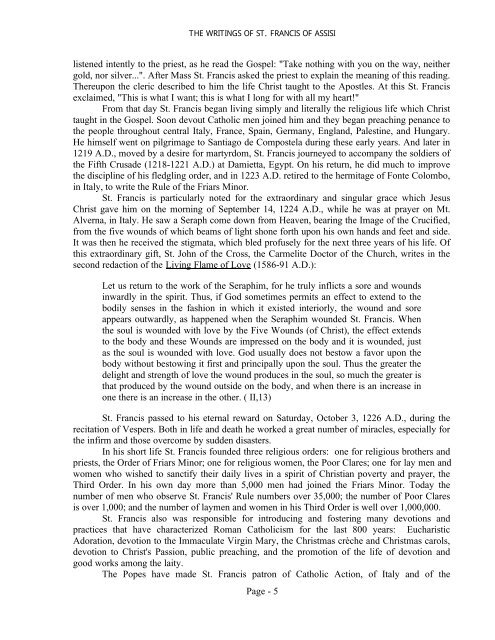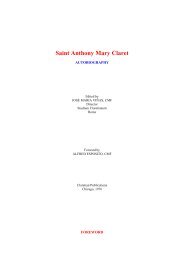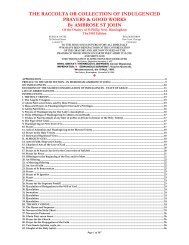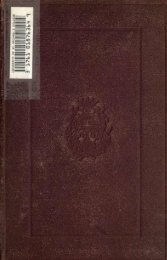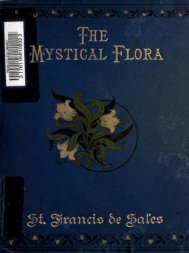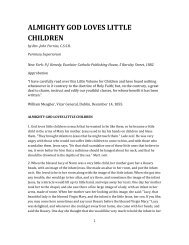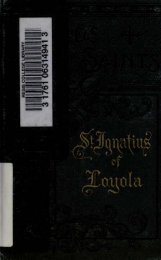The Writings of St. Francis of Assisi - + Saints' Works
The Writings of St. Francis of Assisi - + Saints' Works
The Writings of St. Francis of Assisi - + Saints' Works
Create successful ePaper yourself
Turn your PDF publications into a flip-book with our unique Google optimized e-Paper software.
THE WRITINGS OF ST. FRANCIS OF ASSISI<br />
listened intently to the priest, as he read the Gospel: "Take nothing with you on the way, neither<br />
gold, nor silver...". After Mass <strong>St</strong>. <strong>Francis</strong> asked the priest to explain the meaning <strong>of</strong> this reading.<br />
<strong>The</strong>reupon the cleric described to him the life Christ taught to the Apostles. At this <strong>St</strong>. <strong>Francis</strong><br />
exclaimed, "This is what I want; this is what I long for with all my heart!"<br />
From that day <strong>St</strong>. <strong>Francis</strong> began living simply and literally the religious life which Christ<br />
taught in the Gospel. Soon devout Catholic men joined him and they began preaching penance to<br />
the people throughout central Italy, France, Spain, Germany, England, Palestine, and Hungary.<br />
He himself went on pilgrimage to Santiago de Compostela during these early years. And later in<br />
1219 A.D., moved by a desire for martyrdom, <strong>St</strong>. <strong>Francis</strong> journeyed to accompany the soldiers <strong>of</strong><br />
the Fifth Crusade (1218-1221 A.D.) at Damietta, Egypt. On his return, he did much to improve<br />
the discipline <strong>of</strong> his fledgling order, and in 1223 A.D. retired to the hermitage <strong>of</strong> Fonte Colombo,<br />
in Italy, to write the Rule <strong>of</strong> the Friars Minor.<br />
<strong>St</strong>. <strong>Francis</strong> is particularly noted for the extraordinary and singular grace which Jesus<br />
Christ gave him on the morning <strong>of</strong> September 14, 1224 A.D., while he was at prayer on Mt.<br />
Alverna, in Italy. He saw a Seraph come down from Heaven, bearing the Image <strong>of</strong> the Crucified,<br />
from the five wounds <strong>of</strong> which beams <strong>of</strong> light shone forth upon his own hands and feet and side.<br />
It was then he received the stigmata, which bled pr<strong>of</strong>usely for the next three years <strong>of</strong> his life. Of<br />
this extraordinary gift, <strong>St</strong>. John <strong>of</strong> the Cross, the Carmelite Doctor <strong>of</strong> the Church, writes in the<br />
second redaction <strong>of</strong> the Living Flame <strong>of</strong> Love (1586-91 A.D.):<br />
Let us return to the work <strong>of</strong> the Seraphim, for he truly inflicts a sore and wounds<br />
inwardly in the spirit. Thus, if God sometimes permits an effect to extend to the<br />
bodily senses in the fashion in which it existed interiorly, the wound and sore<br />
appears outwardly, as happened when the Seraphim wounded <strong>St</strong>. <strong>Francis</strong>. When<br />
the soul is wounded with love by the Five Wounds (<strong>of</strong> Christ), the effect extends<br />
to the body and these Wounds are impressed on the body and it is wounded, just<br />
as the soul is wounded with love. God usually does not bestow a favor upon the<br />
body without bestowing it first and principally upon the soul. Thus the greater the<br />
delight and strength <strong>of</strong> love the wound produces in the soul, so much the greater is<br />
that produced by the wound outside on the body, and when there is an increase in<br />
one there is an increase in the other. ( II,13)<br />
<strong>St</strong>. <strong>Francis</strong> passed to his eternal reward on Saturday, October 3, 1226 A.D., during the<br />
recitation <strong>of</strong> Vespers. Both in life and death he worked a great number <strong>of</strong> miracles, especially for<br />
the infirm and those overcome by sudden disasters.<br />
In his short life <strong>St</strong>. <strong>Francis</strong> founded three religious orders: one for religious brothers and<br />
priests, the Order <strong>of</strong> Friars Minor; one for religious women, the Poor Clares; one for lay men and<br />
women who wished to sanctify their daily lives in a spirit <strong>of</strong> Christian poverty and prayer, the<br />
Third Order. In his own day more than 5,000 men had joined the Friars Minor. Today the<br />
number <strong>of</strong> men who observe <strong>St</strong>. <strong>Francis</strong>' Rule numbers over 35,000; the number <strong>of</strong> Poor Clares<br />
is over 1,000; and the number <strong>of</strong> laymen and women in his Third Order is well over 1,000,000.<br />
<strong>St</strong>. <strong>Francis</strong> also was responsible for introducing and fostering many devotions and<br />
practices that have characterized Roman Catholicism for the last 800 years: Eucharistic<br />
Adoration, devotion to the Immaculate Virgin Mary, the Christmas crèche and Christmas carols,<br />
devotion to Christ's Passion, public preaching, and the promotion <strong>of</strong> the life <strong>of</strong> devotion and<br />
good works among the laity.<br />
<strong>The</strong> Popes have made <strong>St</strong>. <strong>Francis</strong> patron <strong>of</strong> Catholic Action, <strong>of</strong> Italy and <strong>of</strong> the<br />
Page - 5


